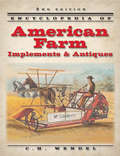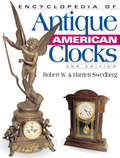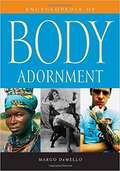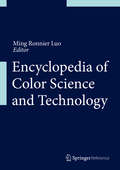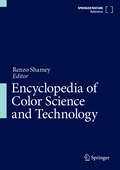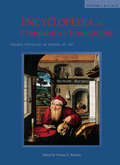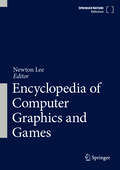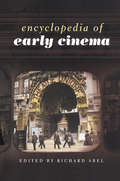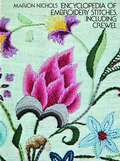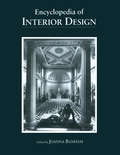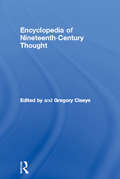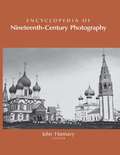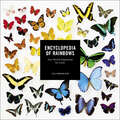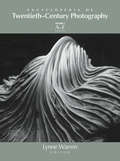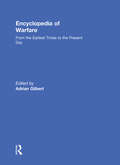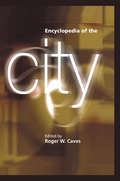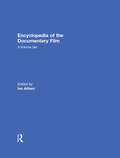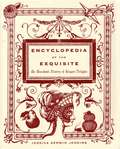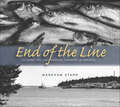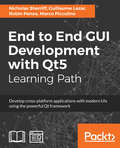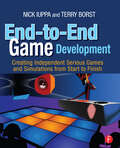- Table View
- List View
Encyclopedia of American Farm Implements & Antiques
by C H WendelThe evolution of the modern farm Finally, an encyclopedia reference work covering American farm implements and farm-related antiques from the 1800s through the 1940s. Through Encyclopedia of American Farm Implements & Antiques, follow the exciting and fascinating technological advances in farm equipment that made the United States the breadbasket to the world. Thoroughly researched, this guide features nearly 2,000 rare illustrations of farm equipment - the most poplar to the most obscure - from firms such as Deere & Co., J.I. Case, Allis-Chalmers, International Harvester and McCormick. Trace the history of: Alfalfa Grinders Balers Corn Binders Corn Harvesters Cultivators Elevators Drills Hay Tools Milking Machines Plows Saws Threshers Washing Machines Plus Much More! If you have an interest in farming and history, you'll love Encyclopedia of American Farm Implements & Antiques. Not only does it identify and illustrate farm equipment, but it explains how this equipment was used and reveals many of the trials and tribulations farmers faced in using it. Also includes current price ranges for thousands of implements and antiques.
Encyclopedia of American Folk Art
by Gerard C. Wertkin Lee KoganFor a full list of entries, contributors, and more, visit the Encyclopedia of American Folk Art web site.This is the first comprehensive, scholarly study of a most fascinating aspect of American history and culture. Generously illustrated with both black and white and full-color photos, this A-Z encyclopedia covers every aspect of American folk art, encompassing not only painting, but also sculpture, basketry, ceramics, quilts, furniture, toys, beadwork, and more, including both famous and lesser-known genres.Containing more than 600 articles, this unique reference considers individual artists, schools, artistic, ethnic, and religious traditions, and heroes who have inspired folk art. An incomparable resource for general readers, students, and specialists, it will become essential for anyone researching American art, culture, and social history.
Encyclopedia of Antique American Clocks
by C H WendelFrom old schoolhouse clocks to stately grandfather clocks, the Encyclopedia of Antique American Clocks presents the most comprehensive guide to America's clocks. More than 700 photographs of clocks include detailed descriptions and current market values. The clocks are presented in an easy-to-follow format organized by clock type. Also included is information about the major clock manufacturers, and overview of clock types and a brief history of clock making. Arranged by clock type, the Encyclopedia of Antique American Clocks includes: Grandfather clocks Wall clocks Classic clocks Shelf clocks Novelty clocks Special chapters on: Clock types History of clock making Clocks from smaller clock makers Leading clock makers Glossary Bibliography Photo index
Encyclopedia of Body Adornment
by Margo DeMelloPeople everywhere have attempted to change their bodies in an effort to meet their cultural standards of beauty, as well as their religious and/or social obligations. Often times, this modification or adornment of their bodies is part of the complex process of creating and re-creating personal and social identities. <p><p> Body painting has probably been practiced since the Paleolithic as archaeological evidence indicates, and the earliest human evidence of tattooing goes back to the Neolithic with mummies found in Europe, Central Asia, the Andes and the Middle East. Adornments such as jewelry have been found in the earliest human graves and bodies unearthed from five thousand years ago show signs of intentional head shaping. <p><p> It is clear that adorning and modifying the body is a central human practice. Over 200 entries address the major adornments and modifications, their historical and cross-cultural locations, and the major cultural groups and places in which body modification has been central to social and cultural practices. <p><p> This encyclopedia also includes background information on the some of the central figures involved in creating and popularizing tattooing, piercing, and other body modifications in the modern world. Finally, the book addresses some of the major theoretical issues surrounding the temporary and permanent modification of the body, the laws and customs regarding the marking of the body, and the social movements that have influenced or embraced body modification, and those which have been affected by it.
Encyclopedia of Color Science and Technology
by Ming Ronnier LuoThe Encyclopedia of Color Science and Technology provides an authoritative single source for understanding and applying the concepts of color to all fields of science and technology, including artistic and historical aspects of color. Many topics are discussed in this timely reference, including an introduction to the science of color, and entries on the physics, chemistry and perception of color. Color is described as it relates to optical phenomena of color and continues on through colorants and materials used to modulate color and also to human vision of color. The measurement of color is provided as is colorimetry, color spaces, color difference metrics, color appearance models, color order systems and cognitive color. Other topics discussed include industrial color, color imaging, capturing color, displaying color and printing color. Descriptions of color encodings, color management, processing color and applications relating to color synthesis for computer graphics are included in this work. The Encyclopedia also delves into color as it applies to other domains such as art and design - ie - color design, color harmony, color palettes, color and accessibility, researching color deficiency, and color and data visualization. There is also information on color in art conservation, color and architecture, color and educations, color and culture, and an overview of the history of color and comments on the future of color. This unique work will extend the influence of color to a much wider audience than has been possible to date.
Encyclopedia of Color Science and Technology
by Renzo ShameyThis fully revised and expanded 2nd edition provides a single authoritative resource describing the concepts of color and the application of color science across research and industry. Significant changes for the 2nd edition include: New and expanded sections on color engineeringMore entries on fundamental concepts of color science and color termsMany additional entries on specific materialsFurther material on optical concepts and human visual perceptionAdditional articles on organisations, tools and systems relevant to colorA new set of entries on 3D presentation of color In addition, many of the existing entries have been revised and updated to ensure that the content of the encyclopedia is current and represents the state of the art. The work covers the full gamut of color: the fundamentals of color science; the physics and chemistry; color as it relates to optical phenomena and the human visual system; and colorants and materials. The measurement of color is described through entries on colorimetry, color spaces, color difference metrics, color appearance models, color order systems and cognitive color. The encyclopedia also has extensive coverage of applications throughout industry, including color imaging, color capture, display and printing, and descriptions of color encodings, color management, processing color and applications relating to color synthesis for computer graphics are included. The broad scope of the work is illustrated through entries on color in art conservation, color and architecture, color and education, color and culture, and biographies of some of the key figures involved in color research throughout history. With over 250 entries from color science researchers across academia and industry, this expanded 2nd edition of the Encyclopedia of Color Science and Technology remains the most important single resource in color science.
Encyclopedia of Comparative Iconography: Themes Depicted in Works of Art
by Helene E. RobertsFirst published in 1998. The Encyclopedia of Comparative Iconography compares the uses of iconographic themes from mythology, the Bible and other sacred texts, literature, and popular culture in works of art through various periods, cultures, and genres. Art historians now tend to study narrative themes depicted in works of art in relation to such subjects as gender and sexuality, politics and power, ownership and possession, ceremony and ritual, legitimacy and authority. The Encyclopedia of Comparative Iconography reflects these new approaches by ordering the themes of various iconographic sources in particular biblical, mythological, and literary texts according to these new emphases.Each handsomely illustrated entry discusses the major relevant iconographic narratives and the historical background of each theme. A list of selected works of art that accompanies each essay guides the reader to examples in art that depict the theme under discussion. Each essay includes a list of suggested reading that provides further sources of information about the themes. A general bibliography of reference books is listed separately and can be used in association with all the essays. With 119 entries written by 42 experts, the Encyclopedia of Comparative Iconography is an important reference work for art historians, students of art history, artists, and the general reader.
Encyclopedia of Computer Graphics and Games
by Newton LeeEncyclopedia of Computer Graphics and Games (ECGG) is a unique reference resource tailored to meet the needs of research and applications for industry professionals and academic communities worldwide. The ECGG covers the history, technologies, and trends of computer graphics and games.EditorNewton Lee, Institute for Education, Research, and Scholarships, Los Angeles, CA, USA Academic Co-ChairsShlomo Dubnov, Department of Music and Computer Science and Engineering, University of California San Diego, San Diego, CA, USAPatrick C. K. Hung, University of Ontario Institute of Technology, Oshawa, ON, CanadaJaci Lee Lederman, Vincennes University, Vincennes, IN, USAIndustry Co-ChairsShuichi Kurabayashi, Cygames, Inc. & Keio University, Kanagawa, JapanXiaomao Wu, Gritworld GmbH, Frankfurt am Main, Hessen, Germany Editorial Board MembersLeigh Achterbosch, School of Science, Engineering, IT and Physical Sciences, Federation University Australia Mt Helen, Ballarat, VIC, AustraliaRamazan S. Aygun, Department of Computer Science, Kennesaw State University, Marietta, GA, USABarbaros Bostan, BUG Game Lab, Bahçeşehir University (BAU), Istanbul, TurkeyAnthony L. Brooks, Aalborg University, Aalborg, DenmarkGuven Catak, BUG Game Lab, Bahçeşehir University (BAU), Istanbul, TurkeyAlvin Kok Chuen Chan, Cambridge Corporate University, Lucerne, SwitzerlandAnirban Chowdhury, Department of User Experience and Interaction Design, School of Design (SoD), University of Petroleum and Energy Studies (UPES), Dehradun, Uttarakhand, IndiaSaverio Debernardis, Dipartimento di Meccanica, Matematica e Management, Politecnico di Bari, Bari, ItalyAbdennour El Rhalibi, Liverpool John Moores University, Liverpool, UKStefano Ferretti, Department of Computer Science and Engineering, University of Bologna, Bologna, ItalyHan Hu, School of Information and Electronics, Beijing Institute of Technology, Beijing, ChinaMs. Susan Johnston, Select Services Films Inc., Los Angeles, CA, USAChris Joslin, Carleton University, Ottawa, CanadaSicilia Ferreira Judice, Department of Computer Science, University of Calgary, Calgary, CanadaHoshang Kolivand, Department Computer Science, Faculty of Engineering and Technology, Liverpool John Moores University, Liverpool, UKDario Maggiorini, Department of Computer Science, University of Milan, Milan, ItalyTim McGraw, Purdue University, West Lafayette, IN, USAGeorge Papagiannakis, ORamaVR S.A., Heraklion, Greece; FORTH-ICS, Heraklion Greece University of Crete, Heraklion, GreeceFlorian Richoux, Nantes Atlantic Computer Science Laboratory (LINA), Université de Nantes, Nantes, FranceAndrea Sanna, Dipartimento di Automatica e Informatica, Politecnico di Torino, Turin, ItalyYann Savoye, Institut fur Informatik, Innsbruck University, Innsbruck, AustriaSercan Şengün, Wonsook Kim School of Art, Illinois State University, Normal, IL, USARuck Thawonmas, Ritsumeikan University, Shiga, JapanVinesh Thiruchelvam, Asia Pacific University of Technology & Innovation, Kuala Lumpur, MalaysiaRojin Vishkaie, Amazon, Seattle, WA, USADuncan A. H. Williams, Digital Creativity Labs, Department of Computer Science, University of York, York, UKSai-Keung Wong, National Chiao Tung University, Hsinchu, TaiwanEditorial Board InternSa
Encyclopedia of Early Cinema
by Richard AbelThis encyclopedia presents a wealth of information on early cinema history, with coverage of the techniques and equipment of film production, profiles of the pioneering directors and producers, analysis of individual films and the rapid growth of distinct film genres, and the emergence of something the world had never seen before - the movie star.The work also focuses on how the nature of film exhibition changed as the industry grew, and how the public's reception to films also changed. The pre-cinema period is closely examined to show those mass-cultural forms and practices - such as music hall and vaudeville - from within which cinema was to emerge. A perfect companion for any student of early cinema and film studies.
Encyclopedia of Embroidery Stitches, Including Crewel
by Marion NicholsLet one of the most accomplished and creative crewel and embroidery experts into you home to teach you the ABCs of these increasingly popular handicrafts. Just turn the pages of this encyclopedic handbook and you will find her precise explanations and clear illustrations on how to work 178 different stitches and their variations.Logically organized for easy use, the book is divided into ten sections. Each is devoted to one of the basic families of stitches, differentiated from the others by its own distinctive motion. Taking one family at a time, the author classifies its various stitches into different groups -- such as isolated, isolated variations, line, angled line, grouped -- and explains them in their order of difficulty. The clear, lucid text and carefully drawn diagrams -- over 1,400 in all -- together present the step-by-step working of each stitch. Illustrations of both the front and back of finished stitches are included.Among the 178 stitches in such families as chain, straight, knotted, couched, and woven, are such variations as the Bosnian, Cable Outline, Whipped Satin, Lazy Daisy, Eyelet Buttonhole, Double Feather, Palestrina, Raised Lattice Band, and scores of others. In addition to the detailed working instructions, the author notes the basic rhythm of each stitch, direction of work, appropriate uses, and other pertinent information.This is an excellent workbook for all who want to learn these highly creative and satisfying stitches, and an ideal refresher course and reference for more experienced needleworkers.
Encyclopedia of Interior Design
by Joanna Banham Leanda ShrimptonFrom ancient Greece to Frank Lloyd Wright, studiola to smoking rooms, chimney boards to cocktail cabinets, and papier-mâché to tubular steel, the Encyclopedia of Interior Design provides a history of interior decoration and design from ancient times to the present day. It includes more than 500 illustrated entries covering a variety of subjects ranging from the work of the foremost designers, to the origins and function of principal rooms and furnishing types, as well as surveys of interior design by period and nationality all prepared by an international team of experts in the field. Entries on individuals include a biography, a chronological list of principal works or career summary, a primary and secondary bibliography, and a signed critical essay of 800 to 1500 words on the individual's work in interior design. The style and topic entries contain an identifying headnote, a guide to main collections, a list of secondary sources, and a signed critical essay.
Encyclopedia of Nineteenth Century Thought
by Gregory ClaeysEncyclopedia of Nineteenth Century Thought provides essential information on, and a critical interpretation of, nineteenth-century thought and nineteenth-century thinkers. The project takes as its temporal boundary the period 1789 to 1914. Encyclopedia of Nineteenth Century Thought primarily covers social and political thinking, but key entries also survey science, religion, law, art, concepts of modernity, the body and health, and so on, and thereby take into account all of the key developments in the intellectual history of the period. The encyclopedia is alphabetically organized, and consists of:* principal entries, divided into ideas (4000 words) and persons (2500 words)* subsidiary entries of 1000 words, which are entirely biographical* informational entries of 500 words, which are also biographical.
Encyclopedia of Nineteenth-Century Photography
by John HannavyThe Encyclopedia of Nineteenth-Century Photography is the first comprehensive encyclopedia of world photography up to the beginning of the twentieth century. It sets out to be the standard, definitive reference work on the subject for years to come. Its coverage is global – an important ‘first’ in that authorities from all over the world have contributed their expertise and scholarship towards making this a truly comprehensive publication. The Encyclopedia presents new and ground-breaking research alongside accounts of the major established figures in the nineteenth century arena. Coverage includes all the key people, processes, equipment, movements, styles, debates and groupings which helped photography develop from being ‘a solution in search of a problem’ when first invented, to the essential communication tool, creative medium, and recorder of everyday life which it had become by the dawn of the twentieth century. The sheer breadth of coverage in the 1200 essays makes the Encyclopedia of Nineteenth-Century Photography an essential reference source for academics, students, researchers and libraries worldwide.
Encyclopedia of Pepsi-Cola Collectibles
by StoddardThe choice is clear and this comprehensive guide on Pepsi-Cola memorabilia is the only one collectors will need. Divided into four sections - signs, containers, novelties and toys, and paper collectibles - collectors will find everything from early Pepsi trays to cardboard signs, and matchbooks to toys. The Encyclopedia of Pepsi-Cola Collectibles features 2,000 individual items with current values, accurate descriptions, rarity ratings, and full-color photographs, and also presents a fascinating historical perspective of the Pepsi-Cola Company, including the evolution of their famous logo.
Encyclopedia of Rainbows: Our World Organized by Color
by Julie Seabrook ReamThis &“visually arresting&” photography book collects and organizes images from the natural and built world according to the spectrum of colors in a rainbow (Country Living). This playful collection of rainbows is a bright and beautiful appreciation of all the color that surrounds us. Artist Julie Seabrook Ream invites us to see the extraordinary beauty of ordinary objects: she gathers colorful iterations of a single type of thing, from feathers to fishing gear, matchbooks to macarons, and neatly arranges them in rainbow order. A fascinating index details all the objects in each rainbow, bringing the magnetic appeal of meticulous organization to this burst of color in book form. This celebratory book is a treasure for those who love art, design, and a fresh perspective. &“[These images] kinda just make you feel like everything is right with the world.&” —BuzzFeed &“The perfect book for color organizing enthusiasts.&” —Mental Floss &“Whether you&’re a color fiend or an organization enthusiast, Encyclopedia of Rainbows is sure to make you see the world around you through a whole new (colorful) lens.&” —My Modern Met &“Encyclopedia of Rainbows is a reminder to stay curious: To think about the natural colors we might find in nature, the objects we might be overlooking. And to consider what we can create when we bring all of these together.&” —Hello Giggles &“This fun new photography book is filled with rainbows made of everything from flowers to stamps to sweets.&” —Martha Stewart Weddings
Encyclopedia of Television
by Horace NewcombThe Encyclopedia of Television, second edtion is the first major reference work to provide description, history, analysis, and information on more than 1100 subjects related to television in its international context.For a full list of entries, contributors, and more, visit the Encyclo pedia of Television, 2nd edition website.
Encyclopedia of Twentieth-Century Photography, 3-Volume Set
by Lynne WarrenThe Encyclopedia of Twentieth-Century Photography explores the vast international scope of twentieth-century photography and explains that history with a wide-ranging, interdisciplinary manner. This unique approach covers the aesthetic history of photography as an evolving art and documentary form, while also recognizing it as a developing technology and cultural force. This Encyclopedia presents the important developments, movements, photographers, photographic institutions, and theoretical aspects of the field along with information about equipment, techniques, and practical applications of photography. To bring this history alive for the reader, the set is illustrated in black and white throughout, and each volume contains a color plate section. A useful glossary of terms is also included.
Encyclopedia of Warfare: From the Earliest Times to the Present Day
by Adrian GilbertThe Encyclopedia of Warfare is a chronological account of the development of warfare since the beginnings of recorded history. The book is organized in 10 chapters, each of which looks at a particular era in warfare from the ancient world to the present. Each chapter includes color maps of key campaigns, as well as commentary on battles, personalities, troops, and equipment. Sidebars throughout the main narrative focus on noteworthy aspects of the history of conflict. Through its chronological organization and ample use of maps, the Encyclopedia also clearly conveys the link between war and world geographical history. A thorough yet concise exploration of combat throughout human history, this fascinating and informative reference work is an outstanding addition to any library collection.
Encyclopedia of World Political Systems
by DerbyshireThis comprehensive resource provides up-to-date political coverage of every country and political entity in the world today. It incorporates all the major global and regional changes following the decolonization of Hong Kong in 1997, recent leadership changes in China and Russia, the results of the Dayton Peace Accord, the rise of the New Labor Party in the UK, the 1999 elections in Israel and South Africa, and the continued search for peace in the Middle East and Northern Ireland. The economic crisis in Asia and the widespread growth of world nuclear powers are also covered.
Encyclopedia of the City
by Roger W. CavesThe Encyclopedia of the City focuses on the key topics encountered by undergraduates and scholars in urban studies and allied fields. Contributors include major theoreticians and practitioners, and on other individuals, groups, and organizations which study the city or practice in a field that directly or indirectly affects the city, the Encyclopedia necessarily adopts an interdisciplinary and multidisciplinary perspective. A solid but also provocative starting point for wider exploration of the city, this is a first-class work of reference that will be an essential resource for independent study as well as a useful aid in teaching.
Encyclopedia of the Documentary Film 3-Volume Set
by Ian AitkenThe Encyclopedia of the Documentary Film is a fully international reference work on the history of the documentary film from the Lumière brothers' Workers Leaving the Lumière Factory (1885) to Michael Moore's Fahrenheit 911 (2004). This Encyclopedia provides a resource that critically analyzes that history in all its aspects. Not only does this Encyclopedia examine individual films and the careers of individual film makers, it also provides overview articles of national and regional documentary film history. It explains concepts and themes in the study of documentary film, the techniques used in making films, and the institutions that support their production, appreciation, and preservation.
Encyclopedia of the Exquisite: An Anecdotal History of Elegant Delights
by Jessica Kerwin JenkinsEncyclopedia of the Exquisite is a lifestyle guide for the Francophile and the Anglomaniac, the gourmet and the style maven, the armchair traveler and the art lover. It's an homage to the esoteric world of glamour that doesn't require much spending but makes us feel rich. Taking a cue from the exotic encyclopedias of the sixteenth century, which brimmed with mysterious artifacts, Jessica Kerwin Jenkins's Encyclopedia of the Exquisite focuses on the elegant, the rare, the commonplace, and the delightful. A compendium of style, it merges whimsy and practicality, traipsing through the fine arts and the worlds of fashion, food, travel, home, garden, and beauty. Each entry features several engaging anecdotes, illuminating the curious past of each enduring source of beauty. Subjects covered include the explosive history of champagne; the art of lounging on a divan; the emergence of "frillies," the first lacy, racy lingerie; the ancient uses of sweet-smelling saffron; the wild riot incited by the appearance of London's first top hat; Julia Child's tip for cooking the perfect omelet; the polarizing practice of wearing red lipstick during World War II; Louis XIV's fondness for the luscious Bartlett pear; the Indian origin of badminton; Parliament's 1650 attempt to suppress Europe's beauty mark fad; the evolution of the Japanese kimono; the pilgrimage of Central Park's Egyptian obelisk; and the fanciful thrill of dining alfresco. Cleverly illustrated, Encyclopedia of the Exquisite is an ode to life's plenty, from the extravagant to the eccentric. It is a celebration of luxury that doesn't necessarily require money.From the Hardcover edition.
End of the Line: Closing the Last Sardine Cannery in America (The Driftless Connecticut Series)
by Markham StarrAt one time, sardines were an inexpensive staple for many Americans. The 212 photographs in this elegant volume offer a striking document of this now vanished industry. Generations of workers in Maine have snipped, sliced, and packed the small, silvery fish into billions of cans on their way to Americans' lunch buckets and kitchen cabinets. On April 15, 2010, Stinson's Seafood, once the home of Beach Cliff Sardines, shut down the packing line that had made the name world famous. Begun in 1927, Stinson's empire eventually included sardine canneries spread along the Maine coast and a fleet of ships to supply them. With this closing, however, the end of the entire sardine industry in Maine had finally arrived. Photographer Markham Starr was privileged to spend several days at the Stinson factory in Prospect Harbor, one month before it was dismantled, emerging with a collection of remarkable images that transform the parts of the cannery into works of art and capture the resilience of the workers faced with the loss of jobs many had held for decades. This book includes a short essay, and shows the heartland of Maine at its finest.
End to End GUI Development with Qt5: Develop cross-platform applications with modern UIs using the powerful Qt framework
by Guillaume Lazar Robin Penea Nicholas Sherriff Marco PiccolinoLearn the complete Qt ecosystem and its tools and build UIs for mobile and desktop applicationsKey FeaturesUnleash the power of the latest Qt 5.9 with C++14Easily compile, run, and debug your applications from the powerful Qt Creator IDEBuild multi-platform projects that target Android, iOS, Windows, MacOS, Linux, and moreBook DescriptionQt 5.9 is an application development framework that provides a great user experience and develops full-capability applications with Qt Widgets, QML, and even Qt 3D. This learning path demonstrates the power and flexibility of the Qt framework for desktop application development and shows how you can write an application once and deploy it to multiple operating systems. It will address all the challenges while developing cross-platform applications with the Qt framework.This course will give you a better understanding of the Qt framework and tools to resolve serious issues such as linking, debugging, and multithreading. It will also upskill you by explaining how to create a to-do-style app and taking you through all the stages in building a successful project. You will build a suite of apps; while developing these apps, you’ll deepen your knowledge of Qt Quick's layout systems, and see Qt 3D and widgets in action. The next project will be in the industrial and agricultural sectors: making sense of sensor data via a monitoring system. Your apps should run seamlessly across devices and operating systems such as Android, iOS, Windows, or Mac, and be cost-effective by integrating with existing web technologies. You take the role of lead developer and prototype a monitoring system. In doing so, you’ll get to know Qt's Bluetooth and HTTP APIs, as well as the Charts and Web Engine UI modules. These projects will help you gain a holistic view of the Qt framework.What you will learnInstall and configure the Qt Framework and Qt Creator IDEImplement a rich user interface with QMLLearn the fundamentals of QtTest and how to integrate unit testingCreate stunning UIs with Qt Widget and Qt QuickDevelop powerful, cross-platform applications with the Qt frameworkDesign GUIs with Qt Designer and build a library in it for UI previewsBuild a desktop UI with widgets and DesignerGet familiar with multimedia components to handle visual input and outputWho this book is forThis book will appeal to developers and programmers who would like to build GUI-based applications. Knowledge of C++ is necessary and a basic familiarity with Qt would be helpful.
End-to-End Game Development: Creating Independent Serious Games and Simulations from Start to Finish
by Nick Iuppa Terry BorstYou're part of a new venture, an independent gaming company, and you are about to undertake your first development project. The client wants a serious game, one with instructional goals and assessment metrics. Or you may be in a position to green light such a project yourself, believing that it can advance your organization's mission and goals. This book provides a proven process to take an independent game project from start to finish. In order to build a successful game, you need to wear many hats. There are graphic artists, software engineers, designers, producers, marketers - all take part in the process at various (coordinated) stages, and the end result is hopefully a successful game. Veteran game producers and writers (Iuppa and Borst) cover all of these areas for you, with step by step instructions and checklists to get the work done.The final section of the book offers a series of case studies from REAL indy games that have been developed and launched succesfully, and show exactly how the principles outlined in the book can be applied to real world products. The book's associated author web site offers ancillary materials & references as well as serious game demos and presentations.
